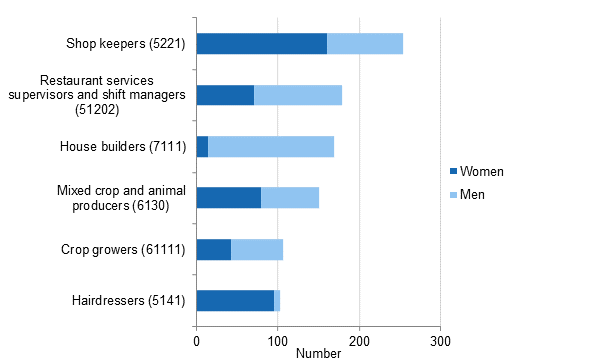Published: 4 November 2016
Shop sales assistants became unemployed most commonly in 2015
According to Statistics Finland's employment statistics, of all employed persons in the end of 2014, some 101,000 were unemployed at the end of 2015 1) .Persons in the occupational groups shop sales assistants (some 4,800), house builders (2,700) and office cleaners (2,600) became unemployed most commonly. The share of persons aged under 29 among shop sales assistants and house builders becoming unemployed was around 30 per cent in 2015. (Appendix table 1.)
Share of persons who became unemployed in 2015 of all employed persons in 2014 by occupational groups (AML 2010), %
| Classification of Occupations 2010 (1-digit level) | Employed 2014 | Unemployed at the end of 2015 | Share of unemployed persons of the employed persons, % |
| 0 Armed forces | 8,504 | 70 | 0.8 |
| 1 Managers | 93,088 | 1,789 | 1.9 |
| 2 Professionals | 435,101 | 12,579 | 2.9 |
| 3 Technicians and associate professionals | 409,710 | 12,217 | 3.0 |
| 4 Clerical support workers | 143,592 | 6,819 | 4.7 |
| 5 Service and sales workers | 466,989 | 20,386 | 4.4 |
| 6 Skilled agricultural, forestry and fishery workers | 63,373 | 1,732 | 2.7 |
| 7 Craft and related trades workers | 227,198 | 18,023 | 7.9 |
| 8 Plant and machine operators, and assemblers | 192,677 | 11,172 | 5.8 |
| 9 Elementary occupations | 152,543 | 11,723 | 7.7 |
| X Unknown | 81,301 | 4,436 | 5.5 |
| Total | 2,274,076 | 100,946 | 4.4 |
In absolute numbers, most persons became unemployed in the main group service and sales workers of the Classification of Occupations (AML 2010), around 20,400 persons. The share of persons becoming unemployed in all main groups was, in turn, largest among craft and related trades workers, around eight per cent
In the main group of service and sales workers, persons became unemployed most common in the occupational groups of shop sales assistants (4,800), cooks (1,470) building caretakers (1,450) and social work assistants (1,450).
Correspondingly, among craft and related trades workers, persons became unemployed most common in the occupational groups of house builders (2,750), carpenters and joiners (2,020), metal working machine tool setters and operators (1,230) and motor vehicle mechanics and repairers (1,080).
Among occupational groups with at least 10,000 employed persons (AML 2010, 5-digit level), the share of persons having become unemployed was highest, around 13 per cent, among carpenters and joiners. Shares of over eight per cent were also found among house builders, hospital and institutional helpers, and teachers' aides. (Appendix Table 2.)
Among wage and salary earners most shop sales assistants became unemployed and among entrepreneurs most shop keepers
Among wage and salary earners, most persons became unemployed in the occupational group of shop sales assistans (around 4,800 persons). The next most common occupational groups to become unemployed were house builders (2,580 persons), office cleaners (2,560), freigth handlers (2,350) and secretaries (general) (2,200). (Appendix table 3.)
Among entrepreneurs, the occupational groups to become unemployed most commonly were shop keepers (around 250 persons), restaurant services supervisors and shift managers (180) and house builders (170). (Appendix table 4.)
Most common occupational groups in 2014 of entrepreneurs that became unemployed in 2015

One in five of those who became unemployed was a young person
The share of those aged under 29 of all persons that became unemployed was 21.4 per cent, around 21,600 persons. The most common occupational groups among young people who became unemployed were almost the same as for all employed persons. Young people had most commonly worked as shop sales assistants (around 1,660 persons), house builders (800), freight handlers (750) and office cleaners (620). (Appendix table 5.)
The share of persons aged under 29 of all shop sales assistants who became unemployed was 34.4 per cent, 31.9 per cent of freight handlers and 29.2 per cent of house builders. Around one-quarter of office cleaners that became unemployed were aged under 29. (Appendix table 1.)
In Statistics Finland's employment statistics for 2014, the occupations of wage and salary earners and entrepreneurs aged 18 to 74 have been classified into occupational groups according to the Classification of Occupations 2010. 2) 3)
1) At the end of 2015, the total number of unemployed persons was around 375,000.
2) Occupation data are produced primarily based on a person's main employment relationship in the last week of the year.
3) The data on occupations remained unknown for some 3.6 per cent of all employed persons in 2014. Of all employed persons in 2014 who became unemployed in 2015, the data on occupations remained unknown for around 4.4 per cent.
Source: Employment Statistics, Statistics Finland
Inquiries: Elina Mikkelä 029 551 2973, Marketta Oinonen 029 551 3602, Merja Rajaniemi 029 551 3607, info@stat.fi
Director in charge: Jari Tarkoma
Publication in pdf-format (248.4 kB)
- Tables
-
Tables in databases
Pick the data you need into tables, view the data as graphs, or download the data for your use.
Appendix tables
- Appendix table 1. Most common occupational groups in 2014 of persons that became unemployed in 2015 1) (4.11.2016)
- Appendix table 2. Biggest shares of employed persons aged 18 to 74 in 2014 that became unemployed in 2015 by occupational groups, % 1) (4.11.2016)
- Appendix table 3. Most common occupational groups in 2014 of wage and salary earners that became unemployed in 2015 1) (4.11.2016)
- Appendix table 4. Most common occupational groups in 2014 of entrepreneurs that became unemployed in 2015 1) (4.11.2016)
- Appendix table 5. Most common occupational groups in 2014 of young persons aged under 29 that became unemployed in 2015 1) (4.11.2016)
Updated 04.11.2016
Official Statistics of Finland (OSF):
Employment [e-publication].
ISSN=2323-6825. Industry, employer sector and jobs 2014. Helsinki: Statistics Finland [referred: 25.4.2025].
Access method: http://stat.fi/til/tyokay/2014/04/tyokay_2014_04_2016-11-04_tie_001_en.html

